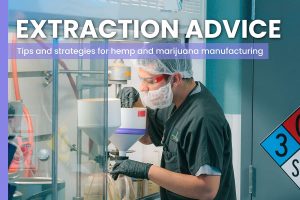
(This is the ninth installment in an ongoing series offering tips and advice for hemp and marijuana extraction companies. The eighth installment is available here.)
Bad headlines are the stuff of nightmares for anyone making consumer products infused with cannabis: Look at this item where the potency didn’t match the label!
Potency errors can sink a company’s reputation and lead to forced product recalls or destruction of whole batches in some jurisdictions.
Even worse, erroneous potency in the CBD space has caught the eye of federal health regulators and caused them to cast doubt on the entire industry.
But nailing a potency goal is harder than it seems.
Cannabis manufacturers are working with a plant that can change dramatically generation to generation, even when grown from clones.
And the industry is so young that lab standards vary from jurisdiction to jurisdiction. A gummy bear that tests at one potency in one state can show at a different potency in another, even when both states use reputable labs.
The problem is only getting worse as cannabis product manufacturers look to expand to new states or, in the case of hemp-derived cannabinoids, nationwide.
No coast-to-coast retailer is interested in carrying an item that can’t pass muster in different jurisdictions.
So Hemp Industry Daily caught up with some seasoned cannabis manufacturers to gather their advice for getting potency just right – and avoiding seeing their products on the evening news as examples of mislabeled products.
Here are four ideas for getting it right every time:
Start at the end
Potency in the end product should be top of mind before the first plant is even processed, said Nick Tennant, chief technology officer at Precision Extraction Solutions, a hemp- and marijuana-extraction company and subsidiary of Sinclair Scientific based in Troy, Michigan.
“It’s all going to start with your product plan,” he said.
“First question is, what product do we want to make? The second question is, in what quantity do we want to make it?
“Decide whether that’s live resin, shatter, budder, a vape cartridge or a formulation for a tincture, a topical or a gel cap. Based upon the end goal, it’s going to dictate what type of process we use.”
Tennant compares cannabis product manufacturing to cooking food at commercial scale.
“You can almost think of it like cooking in a kitchen,” he said. “You have your stove and you have your oven and have all of your individual processes within the kitchen, but there’s no one way to make a certain dish. Every chef kind of has his own recipe.”
Then work backward
Meeting potency goals is easier with consistent inputs.
So, once a product manufacturer decides on a process, it’s time to identify consistent inputs.
For cannabis manufacturers, that means sourcing consistent supply, a challenge when cannabis genetics are new and unstable compared to other commercial crops.
“The first step is securing your supply chain,” said Rachael Kropp, quality manager at Socati Corp., a CBD ingredient manufacturer based in Austin, Texas.
“Make sure that you’re working with suppliers you trust and reliable partners who are able to deliver a consistent quality product,” she said.
Look for suppliers following established sanitation standards known as GAP, or Good Agricultural Practices, or GMP, Good Manufacturing Practice.
“Start talking to people who have certifications and are willing to deliver a good-quality product,” she said.
Test, test, test
Several manufacturers emphasized the importance of testing through the manufacturing process to make sure the potency is where it needs to be.
At Vertosa – an Oakland, California, company that manufactures cannabinoid emulsions for beverage makers such as Pabst Blue Ribbon – founder Harold Han tests each batch for six things:
- Potency.
- Microbial contamination.
- Heavy metals.
- Residual solvents.
- Pesticides.
- Mycotoxins (mold).
“So, when we sell our emulsions to clients, they will know exactly the potency of the emulsion,” he said. “That’s going to be very important to them.”
Pick the right tester
Manufacturers agreed that frequent testing is needed to ensure consistent correct potency.
Problem is, manufacturers also need to keep in mind lab variability.
Unlike other consumer packaged goods, from pet food to pharmaceuticals, cannabis doesn’t have published, multi-laboratory-validated standard test methods.
At Your CBD Store, a 600-outlet chain selling hemp-derived goods across multiple states, Chief Science Officer Anthony Ferrari keeps in mind the labs used by regulators in each jurisdiction and looks to use those labs for internal quality control.
“Send it off to the lab that you’re going to get your finished goods tested on,” he said.
“What we’ve tried to do is figure out where we think we’ll get most reasonable end results.
“So, in the state of Florida, we’ll say, ‘Hey, if the Department of Ag in Florida picks this up off the shelf, they’re probably going to use this lab. So let’s just use this lab for formulation.’”
The extra legwork throughout product manufacturing will help ensure cannabis products meet the desired potency in a repeatable, scalable way.
“It’s important for a brand to be able to meet that potency claim to ensure that their product can stay on the market,” Kropp said. “You want to make sure that consumers have a consistent quality product that they trust.”
Kristen Nichols can be reached at [email protected].

